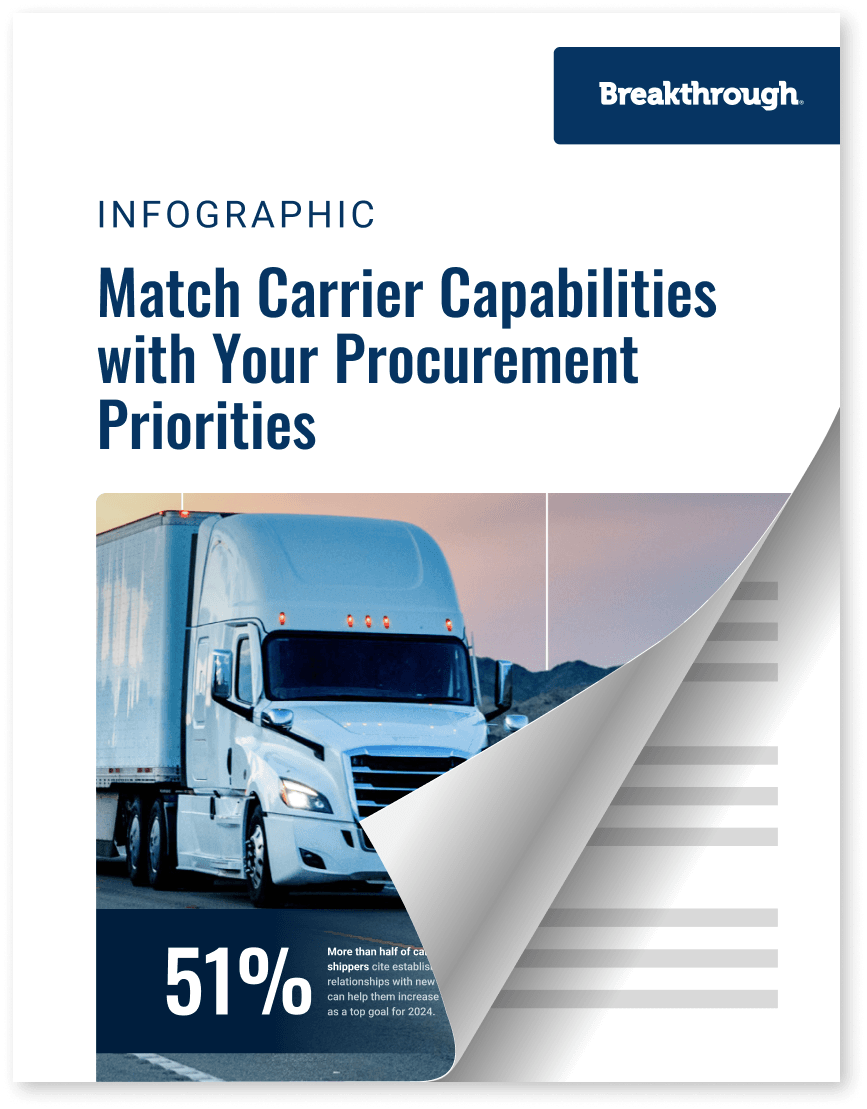Match Carrier Capabilities with Your Procurement Priorities

Freight
3 min read
April 12, 2024
Market Events
2 min read
April 4, 2024
Sustainability and Tech
5 min read
April 4, 2024

8 min read
February 19, 2020

Share:
With increasing numbers of automated trucking technologies being tested and appearing on the market, the industry is at a crossroads. “Automated features” to the layperson often conjure images of futuristic driverless cars operating with fully autonomous features. This, however, is not the case, and automation occurs on a spectrum.
The question then becomes, what levels of autonomy can be adopted in commercial vehicles, and when should each be adopted? The current state of federal policies and regulations for the autonomous trucking market are largely absent, making integration across full networks difficult.
The industry thus faces new questions about the future of automation. Shippers and carriers should stay informed about new technology for semi-trucks and variations in state-to-state regulations. This will create a strategic advantage as we look to the longer-term future and sustainability strategies of shippers.
As more sophisticated vehicle technologies continue to emerge, the opportunities for automated truck options range widely, from providing select driver assistance systems to complete autonomy with no human intervention. These abilities can be divided into five levels, all of which have differing implications for the industry if implemented.
Although autonomous vehicle technology is well recognized as the product of market-disruptors like Peloton, Tesla, and TuSimple, this innovation does not stop here. More legacy, or traditional truck manufacturers, like Daimler, Peterbilt, and Volvo, are also working toward a future that leverages automated technology.

The spectrum for autonomous trucking levels include:
These changes include small shifts toward increased driver assistance. In many cases, these technologies can be seen in both passenger vehicles and heavy-duty trucking on the road today. Level 1, for instance, can include adaptive cruise control and lane assist features. Technology at level 1, however, is implemented independently of other autonomous features.
Level 2 involves two primary control functions working together. Leading-edge companies such as Peloton and Tesla have implemented these levels of automation in prototype fleets.
Level 3 is where automation starts to become more intensive. Fully autonomous solutions begin to emerge in instances where highway driving is consistent and predictable – like long-haul routes. The driver chooses which automated features to employ and most miles are traveled autonomously. But The driver maintains ultimate control of the vehicle throughout the duration.
Instances, where driver intervention is required include subpar weather events that limit connectivity and visibility, and more variable urban and city driving that requires frequent starting and stopping.
Level 4 automation is similar to Level 3 in that the driver is still present, but at this level, the vehicle would be operating fully on its own in all scenarios. Most companies are jumping Level 3 and striving for Level 4.
For example, Waymo is testing Level 4 technology within their own business but have yet to move into the commercial sphere. TuSimple, founded in 2015, is another market leader that is testing automated vehicles at the higher levels of automation. TuSimple operates 200 trucks in the united states and 500 global trucks over millions of miles of testing throughout 2019.
Level 5 is perhaps the furthest from the reality of today’s trucking industry. Humans would no longer be driving trucks – or even present – and vehicles would be fully-automated.
Level 5 automation is more prevalent overseas, specifically in Sweden where two companies – Einride and Volvo – are testing Level 5 technology in controlled, low speed, short distance environments.
Increasing levels of automation bring new possibilities for safety and efficiency because it removes the most variable element of heavy-duty truck driving—human error.
Technology at Levels 2 and 3 focuses on increasing aerodynamics, saving fuel, and locating ideal speeds for efficiency. Examples include navigation software that allows drivers to locate more fuel-efficient routes. Others will optimize operating functions like speed and braking which can make automation as good as, if not better than, the most efficient driver.
Automated vehicles at Levels 4 and 5 include technology that enhances operational functionality. This translates into significantly reduced safety hazards on the road. Automated trucks at these levels could include abilities to improve stability (preventing skidding or rollovers) or faster reaction times and stopping features than most humans reacting to external stimuli.
Peloton is currently pioneering a platooning program designed with these goals in mind, capitalizing on the art of drafting to save on fuel costs. In testing, The Peloton System resulted in 7 percent overall fuel efficiency savings, with the lead truck in a platoon saving 4.5 percent on diesel fuel and the following truck saving 10 percent.
Automation systems like those at Peloton seem to be paving the way toward a more sustainable approach to trucking. Its 2018 report, Driverless? Autonomous Trucks and the Future of the American Trucker, the U.C Berkeley Labor Center estimated that the industry will see about $35 billion in fuel efficiency gains and an overall total of $168 billion saved industry-wide.
McKinsey & Company also noted that automated trucks will bring changes to the efficiency of transportation and supply chains because shipping and production schedules will be tied less to the availability of truck drivers.

Moving toward an autonomous semi-truck market is not without its challenges. While the U.S. is increasingly seeing Level 2 technologies emerge, moving into Level 3 technologies will be the biggest leap to date.
Social attitudes about automated vehicles add barriers to the development or adoption of technology. Fear of an unknown technology rises, with concern for the risks associated with technology failure.
This is often exacerbated by news stories about accidents involving autonomous vehicles. This media coverage can contribute to a negative perception of the technology among consumers and leads to slowed adoption.
Many in the industry ask, “What if the technology doesn’t perform as expected?” Real-world performance is unknown and stagnates development.
In a predictable environment—such as a road shared with other autonomous vehicles—the technology holds true today. But how will the technology perform when surrounded by human behavior which is inconsistent? How will the introduction of unpredictable decision making ultimately impact the safety of other drivers on the road? If systems fail, what safety features are in place to prevent compounded risks?
The role of the driver is also in question, as the driver’s responsibilities will change, and eventually, the demographics of the driver pool will evolve. These factors generate fears about the potential loss of driver jobs. Some sources, however, say that increased use of automated trucks can help alleviate the significant shortage of drivers seen throughout 2018 that persisted in 2019.
Beyond these challenges, legislation regulating autonomous vehicle testing differs widely across states. Currently, no federal standard on autonomous trucking technology exists, so every state varies in its acceptance of autonomous trucking technology. Several states have no proposed legislation, meanwhile states like Nevada, California, Texas, and Arizona are hotbeds for testing automated trucks.

Conversely, restrictive policies in certain states and the absence of federal policy has slowed the pace of development and implementation operationally. While some Level 1 and 2 technologies are already integrated into commercial trucks, the advancement of vehicles to higher levels of automation is slow.
Shippers’ transportation networks most often utilize over-the-road trucking strategies that span hundreds of miles across numerous states. The lack of uniformity across the United States makes finding viable, autonomy-compliant routes difficult. As more states—or the federal government—enact legislation that allows automated trucking testing, the solution becomes more practical in real-world applications.
The attitudes toward and standards for autonomous trucking remain in flux. Yet little doubt remains that these autonomous variables will play an increasingly significant role in the future of the industry. Early adopters seeking an increase in safety, efficiency, and sustainability continue to emerge. Ultimately, being informed, open to changes, and taking an active role in the policy realm puts shippers in an advantageous position, as getting in front of these changes allows for more agile supply chains.
Breakthrough’s team is committed to keeping up with the latest news and research on these ever-evolving technologies. For further insights on the impact of autonomous trucking technology on efficiency, safety, and supply chain management, contact us and check out our blog.

3 min read
April 12, 2024
Explore the pivotal role of new carrier partnerships in enhancing efficiency. Discover the considerations to make better carrier procurement decisions.
Read more
2 min read
April 4, 2024
Discover how the EPA's Phase 3 Heavy-Duty Vehicle Emissions Standards will impact transportation.
Read more
5 min read
April 4, 2024
From establishing an emissions baseline to implementing reduction strategies, discover how to efficiently and effectively achieve your sustainability goals.
Read more